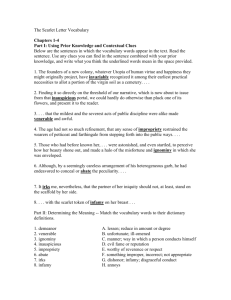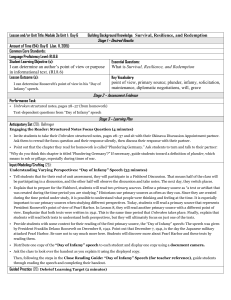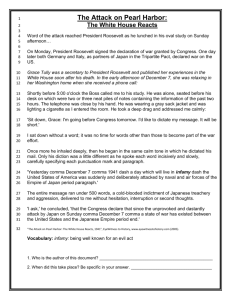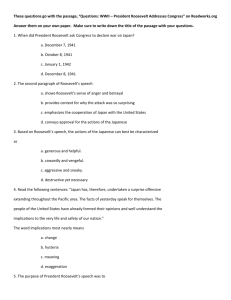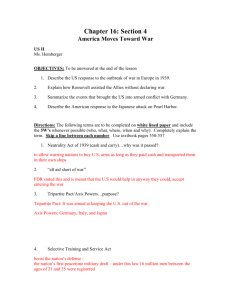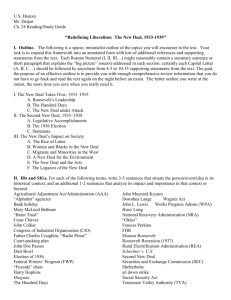Quiz on Roosevelt`s "Day of Infamy" Speech
advertisement
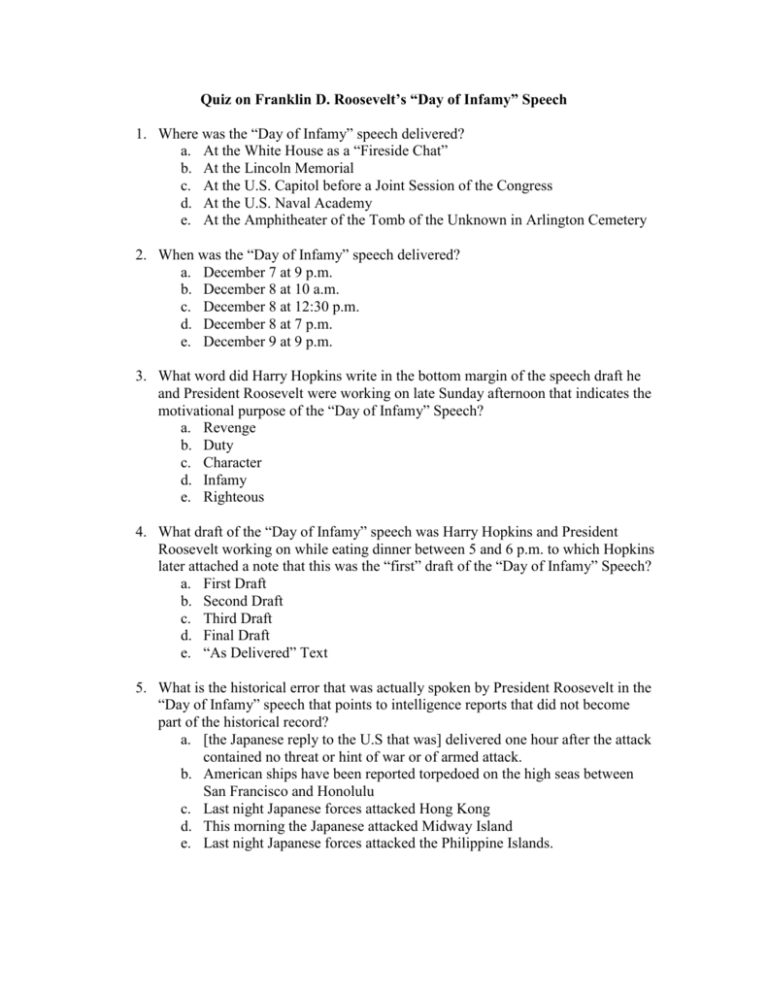
Quiz on Franklin D. Roosevelt’s “Day of Infamy” Speech 1. Where was the “Day of Infamy” speech delivered? a. At the White House as a “Fireside Chat” b. At the Lincoln Memorial c. At the U.S. Capitol before a Joint Session of the Congress d. At the U.S. Naval Academy e. At the Amphitheater of the Tomb of the Unknown in Arlington Cemetery 2. When was the “Day of Infamy” speech delivered? a. December 7 at 9 p.m. b. December 8 at 10 a.m. c. December 8 at 12:30 p.m. d. December 8 at 7 p.m. e. December 9 at 9 p.m. 3. What word did Harry Hopkins write in the bottom margin of the speech draft he and President Roosevelt were working on late Sunday afternoon that indicates the motivational purpose of the “Day of Infamy” Speech? a. Revenge b. Duty c. Character d. Infamy e. Righteous 4. What draft of the “Day of Infamy” speech was Harry Hopkins and President Roosevelt working on while eating dinner between 5 and 6 p.m. to which Hopkins later attached a note that this was the “first” draft of the “Day of Infamy” Speech? a. First Draft b. Second Draft c. Third Draft d. Final Draft e. “As Delivered” Text 5. What is the historical error that was actually spoken by President Roosevelt in the “Day of Infamy” speech that points to intelligence reports that did not become part of the historical record? a. [the Japanese reply to the U.S that was] delivered one hour after the attack contained no threat or hint of war or of armed attack. b. American ships have been reported torpedoed on the high seas between San Francisco and Honolulu c. Last night Japanese forces attacked Hong Kong d. This morning the Japanese attacked Midway Island e. Last night Japanese forces attacked the Philippine Islands. 6. What is the major historical error that was contained the typed text of the first draft of the “Day of Infamy” Speech? a. “Yesterday, December 7, 1941, a date which will live in world history, the United States of America was simultaneously and deliberately attacked by naval and air forces of the Empire of Japan.” b. “Indeed, one hour after, Japanese air squadrons had commenced bombing in Hawaii and the Philippines, the Japanese Ambassador to the United States and his colleague delivered to the Secretary of State a formal reply . . . .” c. “It will be recorded that the distance of Manila, and especially of Hawaii, from Japan make it obvious that their attacks were deliberately planned many days ago.” d. “The attacks yesterday on Manila and on the Island of Oahu has caused severe damage to American naval and military forces.” e. All of the above. 7. How many places that were attacked by the Japanese on December 7, 1941 are named in the “Day of Infamy” speech delivered to the Congress? a. Island of Oahu, Hong Kong, Guam, Philippine Islands b. Dutch East Indies, Borneo, Formosa c. Wake Island, Midway Island d. All of the Above e. Both A and C 8. To whom did President Roosevelt read the draft “Day of Infamy” speech Sunday night? a. Congressional leaders b. Chinese Ambassador c. British Ambassador d. Cabinet Officers e. None of the above 9. Who argued that President Roosevelt should deliver a longer and more detailed speech about U.S. relations with Japan instead of the shorter “Day of Infamy” speech? a. State Department b. Navy Department c. War Department d. Commerce Department e. Vice President 10. What did Harry Hopkins do with the “Day of Infamy” speech that he had written President Roosevelt’s notes during dinner on Sunday evening? a. Accidently left it in the President’s study b. Put it in his suit pocket and took it to his bedroom c. Read it to Mrs. Roosevelt d. Gave it to the typist e. Read it to Judge Rosenman Answers to Quiz on Franklin D. Roosevelt’s “Day of Infamy” Speech 1. 2. 3. 4. 5. c At the U.S. Capitol before a Joint Session of the Congress c 12:30 p.m. b Duty c Third Draft b Only one merchant marine ship on contract with the Army was sunk between San Francisco and Hawaii, SS CYNTHIA OLSON, the reporting error showed that multiple listening stations had picked up the SOS, but there are no historical records in the Roosevelt Presidential Library or the National Archives to know which agencies received these reports. The Federal Communication Commission is the most likely source, but its records from this period are still classified to this day. The Matson liner SS LURLINE also picked up the distress call, but its logbook was seized by the U.S. Navy on arrival in San Francisco and the replacement log book was stolen (or secretly removed) from the National Archive depository in San Bruno, California. 6. e. All of the Above. The first draft of speech which was written no later than mid afternoon Sunday, December 7, 1941 repeatedly refers to “simultaneous” attacks and reads that BOTH Manila and Hawaii were attacked. The Philippines was attacked 11 hours after Pearl Harbor . . . well after the third draft of Roosevelt’s Day of Infamy speech had been typed and edited between 5 and 6 p.m. on Sunday. 7. e. Both A and C. The Philippines had been attacked during the night and before the speech was delivered. 8. d. Cabinet Officers. Harold Ickes records the event in his diary and claims that he contributed one of the lines of the speech. 9. a. State Department. Under Secretary of State Sumner Wells was sent to convince the President and Harry Hopkins as they finished dinner that the longer speech on diplomatic relations with Japan written primarily by Secretary of War Henry Lewis Stimson the week before should be given instead. That speech became a Fireside Chat speech later in the second week of December 1941. 10. b. He evidently put in his suit pocket and never had a chance to give it to the typist because of the back to back meetings first with the Cabinet, then Congressional leaders, and finally Hopkins left the President’s study and took CBS newsman Edward R. Murrow.

